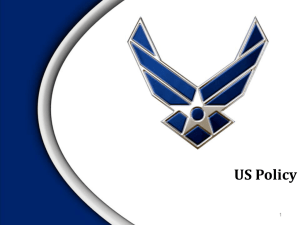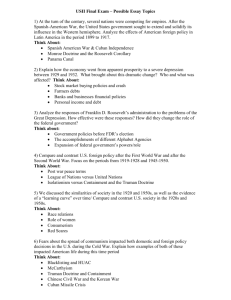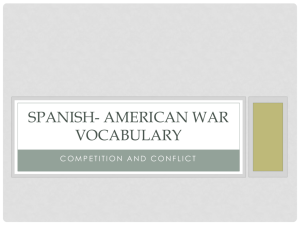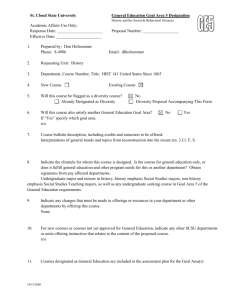US_Policy_12
advertisement
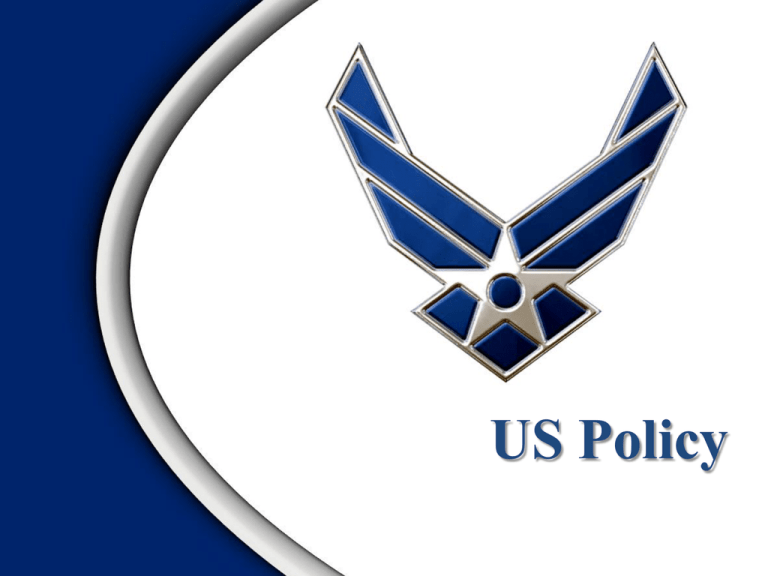
US Policy Foreign Policy • “ a riddle wrapped in a mystery inside an enigma” Winston Churchill (describing Soviet foreign policy) Overview • Definitions – Foreign Policy – National Security Strategy • Policy Influences – Executive Branch – Legislative Branch – The American People Overview • Foreign Policies – – – – – – – – Isolationism Imperialism Pacifism UN Cooperation Containment Post Containment Preemptive Strike National Renewal and Global Leadership US Foreign Policy • The goals and guidelines that shape the conduct of American relations with other nations • How we interact with other countries politically! US National Security Policy • Guidelines for the protection of the nation’s people and territories against physical assault, and protection of vital economic and political interests, the loss of which could threaten fundamental values and the vitality of the nation • How we interact with other countries militarily! NATIONAL SECURITY POLICY + FOREIGN POLICY = Policy Influences • The Executive Branch • The Legislative Branch • The American People Policy Influences • The Executive Branch – – – – The President The State Department The National Security Council (NSC) The National Security Advisor (NSA) Policy Influences • The Legislative Branch – Congress can: • Declare war • Raise and maintain the military • Power of the purse • Treaty ratification • Presidential appointees Policy Influences • The American People – Public opinion • Uninformed public • Informed public • Effective public – Interest groups – The press Foreign Policies • • • • • Isolationism Imperialism Pacifism UN Cooperation Containment – Deterrent Strategies • Post-Containment Era Isolationism (1796) • New nation – Still in turmoil internally • Physical separation • Neutrality & Non-Entanglement – Europe in violent times – Very dependent on European trade • Monroe Doctrine …served us well for a century Imperialism (1893) • Social Darwinism (by Europe) – Colonialism race – United States “expanded overseas” • Hawaii, Guam, Philippines, Puerto Rico • Panama Canal…rebellion against Columbians • Roosevelt Corollary to Monroe Doctrine – “Moral right & obligation to intervene in Latin America” to protect/restore interests …Set the stage for WWI Imperialism (1893) 1914-1918 • World War I • 10 million people lost their lives • “War to end all wars” Pacifism (Post WWI) • United States emerged as world’s most respected country • Treaty of Versailles sought to punish Germany • League of Nations…discuss & settle disputes and not to resort to war…United States rejected • Neutrality acts/Kellogg Peace Pact…outlawed war as legitimate instrument of national policy • United States cut many ties to Europe Setting the stage for WWII... • Harsh reparations on Germany • Great Depression • Lack of treaty enforcement • Lack of political will World War II • The next war to end all wars • Beginning of the atomic age • Over 40 million more die! UN Cooperation (Post WWII) • Had full political backing of United States and USSR…but competition • Stressed “open communication” among nations…international cooperation would preclude war During this same period… Communist Expansion • Soviet Union – Poland, Baltics, Eastern European bloc – Instigated communist rebellions elsewhere • China falls to Communism – Serious blow to US relations …United States felt the need to stop Communist expansion Communist Expansion • Reasons for expansion – Communist doctrine • “Capitalist pigs” – World War II – China’s government had poor admin control Communist Expansion “Let every nation know…that we shall pay any price, bear any burden, meet any hardship, support any friend, oppose any foe to assure the survival and success of liberty” ~ President J. F. Kennedy inaugural address, 1961 Containment • United States had to stop Soviet expansion – Marshall Plan (1947) – Berlin Airlift (1948) – North Atlantic Treaty Organization (1949) • Significantly rebuilt Europe – Countries able to resist communist expansion • Korea – Third World nation stalemated us! – Altered US foreign policy… Massive Retaliation • Focus on technological and strategic superiority • Use nuclear weapons “at a time & place of our choosing” • Launch of Sputnik and ICBM in 1957 – America shocked – America’s age of innocence was over – America changed its deterrent policy once again... Graduated Response • Soviet military capabilities • Expanded alliances in Pacific region – ANZUS Pact (1951) – Japan (1954) • Tactical nuclear weapons – Countered being outnumbered conventionally – Main reason USSR kept in check? • Support SE Asia from communism domino theory …Graduated Response still relied heavily on nukes Flexible Response • • • • • • Respond to any level conflict… Restructure conventional forces Green Berets and Dual Basing Reconstruct airlift and sealift Mutually Assured Destruction No one wins... Then comes Vietnam… Realistic Deterrence/ Nixon Doctrine “…the United States will participate in the defense and development of allies and friends, but… America cannot— and will not—conceive all plans, design all programs, execute all the decisions, and undertake all the defense of the free nations of the world.” ~ President Richard Nixon 18 Feb 1970 Realistic Deterrence/ Nixon Doctrine • Essential Equivalence basic nuclear strategy – Soviet nukes bigger and outnumbered ours, but ours more accurate • Total Force concept to policy – Active duty, National Guard, Reserves • Trained nations to fight, loans, foreign aid – No Troops Watergate…President Carter…Iranian Hostage Crises… Contemporary Containment/ Reagan Doctrine (1981) • More outspoken about dislike of communists and USSR…“Evil Empire” • Military rebuilt – Increased pay raises – New weapon systems • Security Assistance Programs increased – Third World help…stop communist assistance • Allies shouldered more responsibility for own defense End of cold war… World started to change in 1989… • Warsaw Pact crumbling • Berlin Wall coming down • Countries asserting independence from USSR… …leads us to today Post Containment Era: A Strategy of Engagement • To enhance America’s security • To bolster America’s economic prosperity • To promote democracy and human rights abroad Preemptive Strike Era • The “Bush Doctrine”—Signaled a new focus on security by the United States “Our Nation’s cause has always been larger than our Nation’s defense. We fight, as we always fight, for a just peace—a peace that favors liberty. We will defend the peace against the threats from terrorists and tyrants. We will preserve the peace by building good relations among the great powers. And we will extend the peace by encouraging free and open societies on every continent.” ~ President Bush West Point, New York 1 June 2002 Preemptive Strike Era • Key Aspects – Championing human dignity – Strengthening alliances to defeat global terrorism – Preventing our enemies from threatening us with weapons of mass destruction – Expanding the circle of development by opening societies and building the infrastructure of democracy – Transforming America’s national security institutions to meet the challenges and opportunities of the twenty-first century National Renewal and Global Leadership Era • Advancing our Interests – Security – Prosperity – Values – International Order “More than at any point in human history—the interests of nations and peoples are shared. …religious convictions…can forge new bonds among people, or tear us apart. …technology…can light the path to peace, or forever darken it. …energy…can sustain our planet, or destroy it.” —President Barack Obama United Nations General Assembly September 22, 2009 Security • The security of the United States, its citizens, and US allies and partners. Accomplished through: – Strengthening Security and Resilience at Home – Disrupting, Dismantling, and Defeating Al-Qa’ida and its Violent Extremist Affiliates in Afghanistan, Pakistan, and Around the World – Using Force – Reversing the Spread of Nuclear and Biological Weapons and Securing Nuclear Materials – Advancing Peace, Security, and Opportunity in the Greater Middle East – Investing in the Capacity of Strong and Capable Partners – Securing Cyberspace Prosperity • A strong, innovative, and growing US economy in an open international economic system that promotes opportunity and prosperity. Involves: – Strengthening Education and Human Capital – Enhancing Science, Technology, and Innovation – Achieving Balanced and Sustainable Growth – Accelerating Sustainable Development – Spending Taxpayers’ Dollars Wisely Values • Respect for universal values at home and around the world. – Strengthen the Power of Our Example – Promote Democracy and Human Rights Abroad – Promote Dignity by Meeting Basic Needs International Order • An international order advanced by US leadership that promotes peace, security, and opportunity through stronger cooperation to meet global challenges. – Ensure Strong Alliances – Build Cooperation with Other Twenty-First Century Centers of Influence – Strengthen Institutions and Mechanisms for Cooperation – Sustain Broad Cooperation on Key Global Challenges ……Leading to Extremely Exciting Next Era…… Detachment 225 and Universe Leadership Era • Advancing our Future Interests across universe – Fighting For Freedom – ??? – ???? Summary • Definitions • Policy Influences • Foreign Policy 1776 - 1950 – Isolationism through Containment • Deterrent Strategies 1950-89 – Massive Retaliation through Contemporary Containment • Foreign Policies (1989 - ?) – Post Containment Era – Preemptive Strike Era ANY QUESTIONS?
